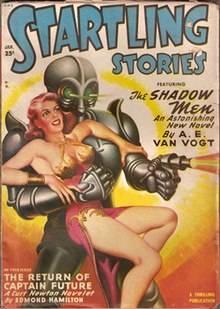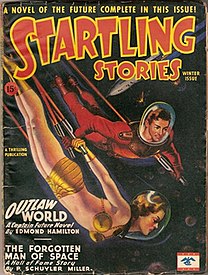
The Magazine of Fantasy & Science Fiction is a U.S. fantasy and science fiction magazine, first published in 1949 by Mystery House, a subsidiary of Lawrence Spivak's Mercury Press. Editors Anthony Boucher and J. Francis McComas had approached Spivak in the mid-1940s about creating a fantasy companion to Spivak's existing mystery title, Ellery Queen's Mystery Magazine. The first issue was titled The Magazine of Fantasy, but the decision was quickly made to include science fiction as well as fantasy, and the title was changed correspondingly with the second issue. F&SF was quite different in presentation from the existing science fiction magazines of the day, most of which were in pulp format: it had no interior illustrations, no letter column, and text in a single-column format, which in the opinion of science fiction historian Mike Ashley "set F&SF apart, giving it the air and authority of a superior magazine".

Unknown was an American pulp fantasy fiction magazine, published from 1939 to 1943 by Street & Smith, and edited by John W. Campbell. Unknown was a companion to Street & Smith's science fiction pulp, Astounding Science Fiction, which was also edited by Campbell at the time; many authors and illustrators contributed to both magazines. The leading fantasy magazine in the 1930s was Weird Tales, which focused on shock and horror. Campbell wanted to publish a fantasy magazine with more finesse and humor than Weird Tales, and put his plans into action when Eric Frank Russell sent him the manuscript of his novel Sinister Barrier, about aliens who own the human race. Unknown's first issue appeared in March 1939; in addition to Sinister Barrier, it included H. L. Gold's "Trouble With Water", a humorous fantasy about a New Yorker who meets a water gnome. Gold's story was the first of many in Unknown to combine commonplace reality with the fantastic.
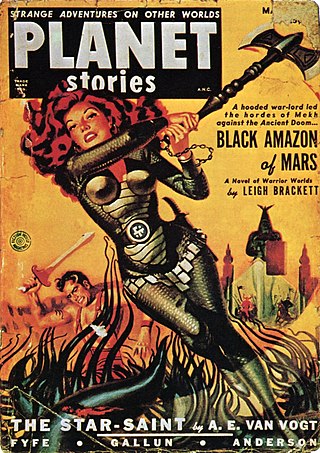
Planet Stories was an American pulp science fiction magazine, published by Fiction House between 1939 and 1955. It featured interplanetary adventures, both in space and on some other planets, and was initially focused on a young readership. Malcolm Reiss was editor or editor-in-chief for all of its 71 issues. Planet Stories was launched at the same time as Planet Comics, the success of which probably helped to fund the early issues of Planet Stories. Planet Stories did not pay well enough to regularly attract the leading science fiction writers of the day, but occasionally obtained work from well-known authors, including Isaac Asimov and Clifford D. Simak. In 1952 Planet Stories published Philip K. Dick's first sale, and printed four more of his stories over the next three years.

Wonder Stories was an early American science fiction magazine which was published under several titles from 1929 to 1955. It was founded by Hugo Gernsback in 1929 after he had lost control of his first science fiction magazine, Amazing Stories, when his media company Experimenter Publishing went bankrupt. Within a few months of the bankruptcy, Gernsback launched three new magazines: Air Wonder Stories, Science Wonder Stories, and Science Wonder Quarterly.

Infinity Science Fiction was an American science fiction magazine, edited by Larry T. Shaw, and published by Royal Publications. The first issue, which appeared in November 1955, included Arthur C. Clarke's "The Star", a story about a planet destroyed by a nova that turns out to have been the Star of Bethlehem; it won the Hugo Award for that year. Shaw obtained stories from some of the leading writers of the day, including Brian Aldiss, Isaac Asimov, and Robert Sheckley, but the material was of variable quality. In 1958 Irwin Stein, the owner of Royal Publications, decided to shut down Infinity; the last issue was dated November 1958.

Beyond Fantasy Fiction was a US fantasy fiction magazine edited by H. L. Gold, with only ten issues published from 1953 to 1955. The last two issues carried the cover title of Beyond Fiction, but the publication's name for copyright purposes remained as before.
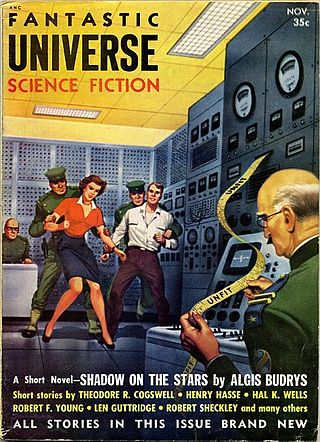
Fantastic Universe was a U.S. science fiction magazine which began publishing in the 1950s. It ran for 69 issues, from June 1953 to March 1960, under two different publishers. It was part of the explosion of science fiction magazine publishing in the 1950s in the United States, and was moderately successful, outlasting almost all of its competitors. The main editors were Leo Margulies (1954–1956) and Hans Stefan Santesson (1956–1960).

Science Fiction Quarterly was an American pulp science fiction magazine that was published from 1940 to 1943 and again from 1951 to 1958. Charles Hornig served as editor for the first two issues; Robert A. W. Lowndes edited the remainder. Science Fiction Quarterly was launched by publisher Louis Silberkleit during a boom in science fiction magazines at the end of the 1930s. Silberkleit launched two other science fiction titles at about the same time: all three ceased publication before the end of World War II, falling prey to slow sales and paper shortages. In 1950 and 1951, as the market improved, Silberkleit relaunched Future Fiction and Science Fiction Quarterly. By the time Science Fiction Quarterly ceased publication in 1958, it was the last surviving science fiction pulp magazine, all other survivors having changed to different formats.
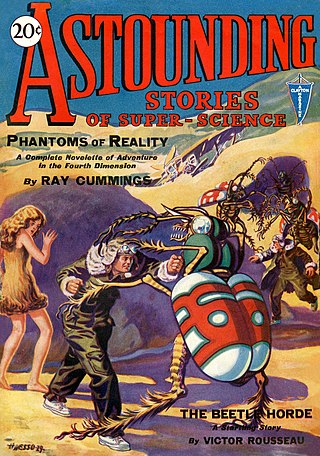
Analog Science Fiction and Fact is an American science fiction magazine published under various titles since 1930. Originally titled Astounding Stories of Super-Science, the first issue was dated January 1930, published by William Clayton, and edited by Harry Bates. Clayton went bankrupt in 1933 and the magazine was sold to Street & Smith. The new editor was F. Orlin Tremaine, who soon made Astounding the leading magazine in the nascent pulp science fiction field, publishing well-regarded stories such as Jack Williamson's Legion of Space and John W. Campbell's "Twilight". At the end of 1937, Campbell took over editorial duties under Tremaine's supervision, and the following year Tremaine was let go, giving Campbell more independence. Over the next few years Campbell published many stories that became classics in the field, including Isaac Asimov's Foundation series, A. E. van Vogt's Slan, and several novels and stories by Robert A. Heinlein. The period beginning with Campbell's editorship is often referred to as the Golden Age of Science Fiction.
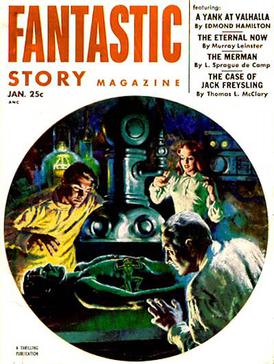
Fantastic Story Quarterlywas a pulp science fiction magazine, published from 1950 to 1955 by Best Books, a subsidiary imprint of Standard Magazines, based in Kokomo, Indiana. The name was changed with the Summer 1951 issue to Fantastic Story Magazine. It was launched to reprint stories from the early years of the science fiction pulp magazines, and was initially intended to carry no new fiction, though in the end every issue contained at least one new story. It was sufficiently successful for Standard to launch Wonder Story Annual as a vehicle for more science fiction reprints, but the success did not last. In 1955 it was merged with Standard's Startling Stories. Original fiction in Fantastic Story included Gordon R. Dickson's first sale, "Trespass", and stories by Walter M. Miller and Richard Matheson.

Famous Fantastic Mysteries was an American science fiction and fantasy pulp magazine published from 1939 to 1953. The editor was Mary Gnaedinger. It was launched by the Munsey Company as a way to reprint the many science fiction and fantasy stories which had appeared over the preceding decades in Munsey magazines such as Argosy. From its first issue, dated September/October 1939, Famous Fantastic Mysteries was an immediate success. Less than a year later, a companion magazine, Fantastic Novels, was launched.

Satellite Science Fiction was an American science-fiction magazine published from October 1956 to April 1959 by Leo Margulies' Renown Publications. Initially, Satellite was digest-sized and ran a full-length novel in each issue with a handful of short stories accompanying it. The policy was intended to help it compete against paperbacks, which were taking a growing share of the market. Sam Merwin edited the first two issues; Margulies took over when Merwin left, and then hired Frank Belknap Long for the February 1959 issue. That issue saw the format change to letter size, in the hope that the magazine would be more prominent on newsstands. The experiment was a failure and Margulies closed the magazine when the sales figures came in.

Future Science Fiction and Science Fiction Stories were two American science fiction magazines that were published under various names between 1939 and 1943 and again from 1950 to 1960. Both publications were edited by Charles Hornig for the first few issues; Robert W. Lowndes took over in late 1941 and remained editor until the end. The initial launch of the magazines came as part of a boom in science fiction pulp magazine publishing at the end of the 1930s. In 1941 the two magazines were combined into one, titled Future Fiction combined with Science Fiction, but in 1943 wartime paper shortages ended the magazine's run, as Louis Silberkleit, the publisher, decided to focus his resources on his mystery and western magazine titles. In 1950, with the market improving again, Silberkleit relaunched Future Fiction, still in the pulp format. In the mid-1950s he also relaunched Science Fiction, this time under the title Science Fiction Stories. Silberkleit kept both magazines on very slim budgets throughout the 1950s. In 1960 both titles ceased publication when their distributor suddenly dropped all of Silberkleit's titles.
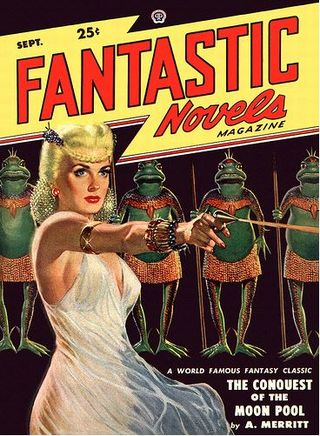
Fantastic Novels was an American science fiction and fantasy pulp magazine published by the Munsey Company of New York from 1940 to 1941, and again by Popular Publications, also of New York, from 1948 to 1951. It was a companion to Famous Fantastic Mysteries. Like that magazine, it mostly reprinted science fiction and fantasy classics from earlier decades, such as novels by A. Merritt, George Allan England, and Victor Rousseau, though it occasionally published reprints of more recent work, such as Earth's Last Citadel, by Henry Kuttner and C. L. Moore.
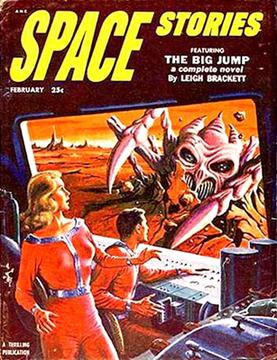
Space Stories was a pulp magazine which published five issues from October 1952 to June 1953. It was published by Standard Magazines, and edited by Samuel Mines. Mines' editorial policy for Space Stories was to publish straightforward science fiction adventure stories. Among the better-known contributors were Jack Vance, Gordon R. Dickson and Leigh Brackett, whose novel The Big Jump appeared in the February 1953 issue.

Strange Stories was a pulp magazine which ran for thirteen issues from 1939 to 1941. It was edited by Mort Weisinger, who was not credited. Contributors included Robert Bloch, Eric Frank Russell, C. L. Moore, August Derleth, and Henry Kuttner. Strange Stories was a competitor to the established leader in weird fiction, Weird Tales. With the launch, also in 1939, of the well-received Unknown, Strange Stories was unable to compete. It ceased publication in 1941 when Weisinger left to edit Superman comic books.

Two Complete Science-Adventure Books was an American pulp science fiction magazine, published by Fiction House, which lasted for eleven issues between 1950 and 1954 as a companion to Planet Stories. Each issue carried two novels or long novellas. It was initially intended to carry only reprints, but soon began to publish original stories. Contributors included Isaac Asimov, Robert A. Heinlein, Arthur C. Clarke, Poul Anderson, John Brunner, and James Blish. The magazine folded in 1954, almost at the end of the pulp era.

Captain Future was a science fiction pulp magazine launched in 1940 by Better Publications, and edited initially by Mort Weisinger. It featured the adventures of Captain Future, a super-scientist whose real name was Curt Newton, in every issue. All but two of the novels in the magazine were written by Edmond Hamilton; the other two were by Joseph Samachson. The magazine also published other stories that had nothing to do with the title character, including Fredric Brown's first science fiction sale, "Not Yet the End". Captain Future published unabashed space opera, and was, in the words of science fiction historian Mike Ashley, "perhaps the most juvenile" of the science fiction pulps to appear in the early years of World War II. Wartime paper shortages eventually led to the magazine's cancellation: the last issue was dated Spring 1944.
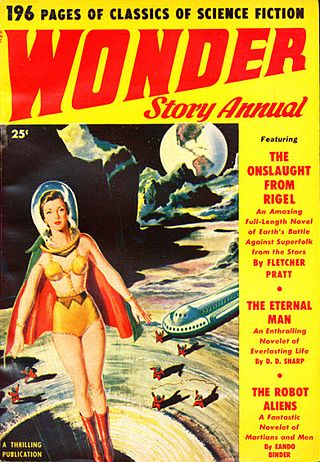
Wonder Story Annual was a science fiction pulp magazine which was launched in 1950 by Standard Magazines. It was created as a vehicle to reprint stories from early issues of Wonder Stories, Startling Stories, and Wonder Stories Quarterly, which were owned by the same publisher. It lasted for four issues, succumbing in 1953 to competition from the growing market for paperback science fiction. Reprinted stories included Twice in Time, by Manly Wade Wellman, and "The Brain-Stealers of Mars", by John W. Campbell.

Science-fiction and fantasy magazines began to be published in the United States in the 1920s. Stories with science-fiction themes had been appearing for decades in pulp magazines such as Argosy, but there were no magazines that specialized in a single genre until 1915, when Street & Smith, one of the major pulp publishers, brought out Detective Story Magazine. The first magazine to focus solely on fantasy and horror was Weird Tales, which was launched in 1923, and established itself as the leading weird fiction magazine over the next two decades; writers such as H.P. Lovecraft, Clark Ashton Smith and Robert E. Howard became regular contributors. In 1926 Weird Tales was joined by Amazing Stories, published by Hugo Gernsback; Amazing printed only science fiction, and no fantasy. Gernsback included a letter column in Amazing Stories, and this led to the creation of organized science-fiction fandom, as fans contacted each other using the addresses published with the letters. Gernsback wanted the fiction he printed to be scientifically accurate, and educational, as well as entertaining, but found it difficult to obtain stories that met his goals; he printed "The Moon Pool" by Abraham Merritt in 1927, despite it being completely unscientific. Gernsback lost control of Amazing Stories in 1929, but quickly started several new magazines. Wonder Stories, one of Gernsback's titles, was edited by David Lasser, who worked to improve the quality of the fiction he received. Another early competitor was Astounding Stories of Super-Science, which appeared in 1930, edited by Harry Bates, but Bates printed only the most basic adventure stories with minimal scientific content, and little of the material from his era is now remembered.
